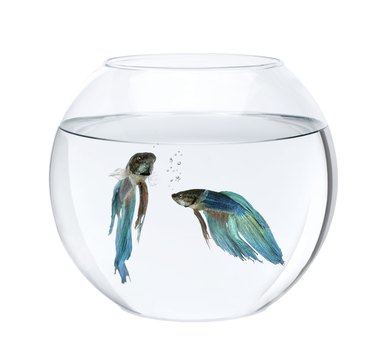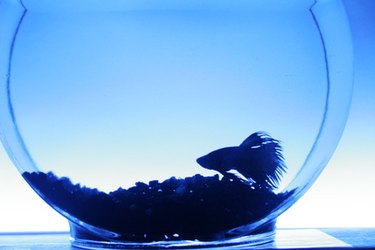
If your favorite betta fish isn't swimming the way he should, there is a chance he is suffering from swim bladder disease. Swim bladder disease is a common problem in bettas but is easily treated. The swim bladder is a gas-filled sac inside your fish. It helps the fish rise and lower in the water much like a buoyancy control device a diver might use. A betta with this disease will either float involuntarily along the surface or they will sink to the bottom of the bowl. Additional symptoms are a lopsided body position while swimming, lethargic behavior and swelling of the stomach. Usually caused by over-feeding and constipation, swim bladder disease is not contagious and is easy to treat.
Tip
Limit fatty foods such as bloodworms and brine shrimp to once a week. They are considered treats. Feeding a betta too much fatty food can lead to constipation and swim bladder disease.
A clean bowl helps prevent swim bladder disease, because elements in an unclean environment can irritate the swim bladder.
It is good practice to skip a day of feeding once a week. A 24-hour fast helps bettas clean out naturally and gives their digestive systems rest.
Bettas that eliminate waste normally but show signs of swim bladder disease may have a bacterial infection or parasites causing the disease. Commercial treatments are available at your local pet store for these problems. Read the labels on the medications to make sure the treatments can be used together safely.
Swim bladder disease caused by an injury requires time for the injury to heal and usually the disease will go away on its own. If your fish continues to struggle to reach the surface for air, place an object in the water that lets the betta rest near the surface.
Video of the Day

Step 1
If your betta is in a community tank, move the fish to a smaller fishbowl. Keep the bowl clean throughout the treatment. When your betta has a bowel movement, use a dropper or small fishnet to remove the waste, preventing bacteria growth and infection. The waste typically looks like one round pellet. Continue the treatment even if your fish has a bowel movement.
Video of the Day
Step 2
If the betta is having trouble reaching the surface to breathe, fill the bowl with only a few inches of filtered water. Add a plant or decoration on which the fish can rest closer to the surface. Bettas use a labyrinth rather than gills to breathe. The labyrinth functions similar to human lungs, and bettas must breathe oxygen from the surface.
Step 3
Do not feed the betta for three days to give its digestive system a chance to rest and naturally clean itself out. If constipation is to blame for the swim bladder disease, this will treat the disease as well.
Step 4
On the fourth day, thaw a frozen pea until it reaches room temperature. The pea works as a laxative. Do not use a fresh pea because it may have harmful pesticides and bacteria. Do not use a canned pea because it contains too much sodium.
Step 5
Remove the outer skin of the pea. Slice off 1/4 of the pea and cut the quarter into betta bite-size pieces. Don't feed the fish any more than that, because its stomach is approximately the size of a betta eye.
Step 6
If your betta still has not eliminated waste by the next day, repeat Steps 3 to 5. Consult a fish specialist at your local veterinarian or pet store for further advice.
Step 7
Once your betta has recovered from swim bladder disease, add a pinch of aquarium salt with each bowl cleaning. This aids in healing and helps prevent infection.